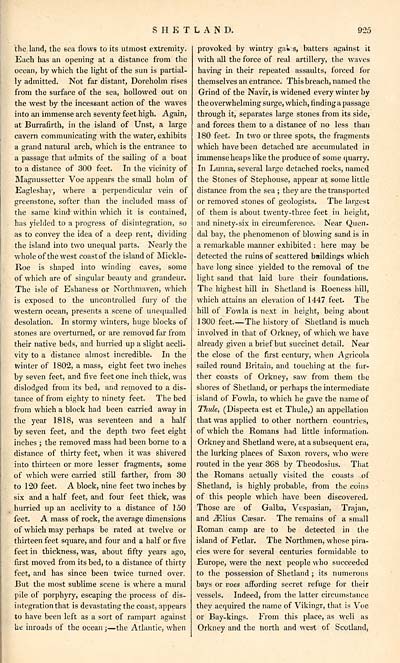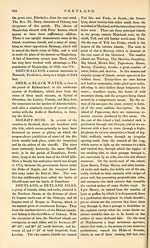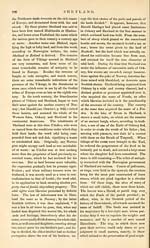Gazetteer of Scotland > Volume 2
(445) Page 925
Download files
Complete book:
Individual page:
Thumbnail gallery: Grid view | List view

S PI E T L A N D.
925
the land, the sea flows to its utmost extremity.
Each has an opening at a distance from the
ocean, by which the light of the sun is partial-
ly admitted. Not far distant, Doreholm rises
from the surface of the sea, hollowed out on
the west by the incessant action of the waves
into an immense arch seventy feet high. Again,
at Burrafirth, in the island of Unst, a large
cavern communicating with the water, exhibits
a grand natural arch, which is the entrance to
a passage that admits of the sailing of a boat
to a distance of 300 feet. In the vicinity of
Magnussetter Voe appears the small holm of
Eagleshav, where a perpendicular vein of
greenstone, softer than the included mass of
the same kind within which it is contained,
has yielded to a progress of disintegration, so
as to convey the idea of a deep rent, dividing
the island into two unequal parts. Nearly the
whole of the west coast of the island of Miekle-
Roe is shaped into winding caves, some
of which are of singular beauty and grandeur.
The isle of Eshaness or Northmaven, which
is exposed to the uncontrolled fury of the
western ocean, presents a scene of unequalled
desolation. In stormy winters, huge blocks of
stones are overturned, or are removed far from
their native beds, and hurried up a slight accli-
vity to a distance almost incredible. In the
winter of 1802, a mass, eight feet two inches
by seven feet, and five feet one inch thick, was
dislodged from its bed, and removed to a dis-
tance of from eighty to ninety feet. The bed
from which a block had been carried away in
the year 1818, was seventeen and a half
by seven feet, and the depth two feet eight
inches ; the removed mass had been borne to a
distance of thirty feet, when it was shivered
into thirteen or more lesser fragments, some
of which were carried still farther, from 30
to 120 feet. A block, nine feet two inches by
six and a half feet, and four feet thick, was
hurried up an acclivity to a distance of 1 50
feet. A mass of rock, the average dimensions
of which may perhaps be rated at twelve or
thirteen feet square, and four and a half or five
feet in thickness, was, about fifty years ago,
first moved from its bed, to a distance of thirty
feet, and has since been twice turned over.
But the most sublime scene is where a mural
pile of porphyry, escaping the process of dis-
integration that is devastating the coast, appears
to have been left as a sort of rampart against
he inroads of the ocean ; — the Atlantic, when
provoked by wintry ga»;s, battei'6 against it
with all the force of real artillery, the waves
having in their repeated assaults, forced for
themselves an entrance. This breach, named the
Grind of the Navir, is widened every winter by
the overwhelming surge, which, finding a passage
through it, separates large stones from its side,
and forces them to a distance of no less than
180 feet. In two or three spots, the fragments
which have been detached are accumulated in
immense heaps like the produce of some quarry.
In Lunna, several large detached rocks, named
the Stones of Stephouse, appear at some little
distance from the sea ; they are the transported
or removed stones of geologists. The largest
of them is about twenty-three feet in height,
and ninety-six in circumference. Near Quen.
dal bay, the phenomenon of blowing sand is in
a remarkable manner exhibited : here may be
detected the ruins of scattered bmildings which
have long since yielded to the removal of the
light sand that laid bare their foundations.
The highest hill in Shetland is Roeness bill,
which attains an elevation of 1447 feet. The
hill of Fowla is next in height, being about
1300 feet. — The history of Shetland is much
involved in that of Orkney, of which we have
already given a brief but succinct detail. Near
the close of the first century, when Agricola
sailed round Britain, and touching at the fur-
ther coasts of Orkney, saw from them the
shores of Shetland, or perhaps the intermediate
island of Fowla, to which he gave the name of
Thide, (Dispecta est et Thule,) an appellation
that was applied to other northern countries,
of which the Romans had little information.
Orkney and Shetland were, at a subsequent era,
the lurking places of Saxon rovers, who were
routed in the year 368 by Theodosius. That
the Romans actually visited the coasts of
Shetland, is highly probable, from the coins
of this people which have been discovered.
Those are of Galba, Vespasian, Trajan,
and iElius Caesar. The remains of a small
Roman camp are to be detected in the
island of Fetlar. The Northmen, whose pira-
cies were for several centuries formidable to
Europe, were the next people who succeeded
to the possession of Shetland ; its numerous
bays or voes affording secret refuge for their
vessels. Indeed, from the latter circumstance
they acquired the name of Vikingr, that is Voe
or Bay-kings. From this place, as well as
Orkney and the north and west of Scotland,
925
the land, the sea flows to its utmost extremity.
Each has an opening at a distance from the
ocean, by which the light of the sun is partial-
ly admitted. Not far distant, Doreholm rises
from the surface of the sea, hollowed out on
the west by the incessant action of the waves
into an immense arch seventy feet high. Again,
at Burrafirth, in the island of Unst, a large
cavern communicating with the water, exhibits
a grand natural arch, which is the entrance to
a passage that admits of the sailing of a boat
to a distance of 300 feet. In the vicinity of
Magnussetter Voe appears the small holm of
Eagleshav, where a perpendicular vein of
greenstone, softer than the included mass of
the same kind within which it is contained,
has yielded to a progress of disintegration, so
as to convey the idea of a deep rent, dividing
the island into two unequal parts. Nearly the
whole of the west coast of the island of Miekle-
Roe is shaped into winding caves, some
of which are of singular beauty and grandeur.
The isle of Eshaness or Northmaven, which
is exposed to the uncontrolled fury of the
western ocean, presents a scene of unequalled
desolation. In stormy winters, huge blocks of
stones are overturned, or are removed far from
their native beds, and hurried up a slight accli-
vity to a distance almost incredible. In the
winter of 1802, a mass, eight feet two inches
by seven feet, and five feet one inch thick, was
dislodged from its bed, and removed to a dis-
tance of from eighty to ninety feet. The bed
from which a block had been carried away in
the year 1818, was seventeen and a half
by seven feet, and the depth two feet eight
inches ; the removed mass had been borne to a
distance of thirty feet, when it was shivered
into thirteen or more lesser fragments, some
of which were carried still farther, from 30
to 120 feet. A block, nine feet two inches by
six and a half feet, and four feet thick, was
hurried up an acclivity to a distance of 1 50
feet. A mass of rock, the average dimensions
of which may perhaps be rated at twelve or
thirteen feet square, and four and a half or five
feet in thickness, was, about fifty years ago,
first moved from its bed, to a distance of thirty
feet, and has since been twice turned over.
But the most sublime scene is where a mural
pile of porphyry, escaping the process of dis-
integration that is devastating the coast, appears
to have been left as a sort of rampart against
he inroads of the ocean ; — the Atlantic, when
provoked by wintry ga»;s, battei'6 against it
with all the force of real artillery, the waves
having in their repeated assaults, forced for
themselves an entrance. This breach, named the
Grind of the Navir, is widened every winter by
the overwhelming surge, which, finding a passage
through it, separates large stones from its side,
and forces them to a distance of no less than
180 feet. In two or three spots, the fragments
which have been detached are accumulated in
immense heaps like the produce of some quarry.
In Lunna, several large detached rocks, named
the Stones of Stephouse, appear at some little
distance from the sea ; they are the transported
or removed stones of geologists. The largest
of them is about twenty-three feet in height,
and ninety-six in circumference. Near Quen.
dal bay, the phenomenon of blowing sand is in
a remarkable manner exhibited : here may be
detected the ruins of scattered bmildings which
have long since yielded to the removal of the
light sand that laid bare their foundations.
The highest hill in Shetland is Roeness bill,
which attains an elevation of 1447 feet. The
hill of Fowla is next in height, being about
1300 feet. — The history of Shetland is much
involved in that of Orkney, of which we have
already given a brief but succinct detail. Near
the close of the first century, when Agricola
sailed round Britain, and touching at the fur-
ther coasts of Orkney, saw from them the
shores of Shetland, or perhaps the intermediate
island of Fowla, to which he gave the name of
Thide, (Dispecta est et Thule,) an appellation
that was applied to other northern countries,
of which the Romans had little information.
Orkney and Shetland were, at a subsequent era,
the lurking places of Saxon rovers, who were
routed in the year 368 by Theodosius. That
the Romans actually visited the coasts of
Shetland, is highly probable, from the coins
of this people which have been discovered.
Those are of Galba, Vespasian, Trajan,
and iElius Caesar. The remains of a small
Roman camp are to be detected in the
island of Fetlar. The Northmen, whose pira-
cies were for several centuries formidable to
Europe, were the next people who succeeded
to the possession of Shetland ; its numerous
bays or voes affording secret refuge for their
vessels. Indeed, from the latter circumstance
they acquired the name of Vikingr, that is Voe
or Bay-kings. From this place, as well as
Orkney and the north and west of Scotland,
Set display mode to: Large image | Transcription
Images and transcriptions on this page, including medium image downloads, may be used under the Creative Commons Attribution 4.0 International Licence unless otherwise stated. ![]()
| Gazetteers of Scotland, 1803-1901 > Gazetteer of Scotland > Volume 2 > (445) Page 925 |
|---|
| Permanent URL | https://digital.nls.uk/97436162 |
|---|
| Description | Volume II: Glenbanchor to Zetland. |
|---|---|
| Attribution and copyright: |
|
| Description | By Robert Chambers and William Chambers. Glasgow: Blackie & Son, 1838. 2 volumes. |
|---|---|
| Shelfmark | NF.1461.g.7 |
| Additional NLS resources: | |

